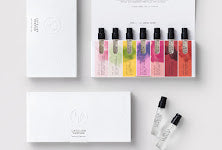Skincare & Cancer
Written by Nicola Meir Holistic Therapies
One in two of us will be diagnosed with cancer in our lifetime. It’s a scary thought, isn’t it? However, treatments are continuously developing which is really encouraging, giving lots of us huge hope for the future. Many of you may have heard that David, one of the co-owners / founders of Perfumery & Co, was diagnosed with throat cancer last year. He underwent some invasive surgery followed by six weeks of daily radiotherapy. He has now been given the all clear which deserves a huge celebration. However, it was unbelievably intense and, even though he was given a treatment plan, he understandably found it extremely daunting and anxiety inducing. He understands how utterly out of control you can feel once diagnosed and fully emersed in a treatment journey. He was desperate to gain a sense of control in other areas of his life, no matter how small they seemed, and one such area was his skincare routine. Taking care of his skin allowed him to regain lost confidence and continue working which he loves. He has shared his experiences with me which I’ve incorporated into this article.
So here are some tips if you, or someone you know, has cancer and is wanting to claw back some control and normality into their day to day life. One small way of doing this is in the form of skin care. Think of it as creating a selfcare ritual, rather than a mundane routine. Something you choose to do, rather than something you have to do. A chance to take some time for yourself in order to look and feel just a little bit better. After all, when something becomes a ritual it is more enjoyable and the benefits are multiple.
It is important to say at this point that we advise chatting to your healthcare professional about making changes to your skincare and at any point where you may have concerns or questions about your skin. Both chemotherapy and radiotherapy have a huge impact on the skin and are ultimately killing cancerous cells and preventing them from reproducing and growing. In doing so, they affect our healthy cells leading to changes in our skin. Radiotherapy can cause skin, on the part of the body receiving radiation, to become dry, itchy and peel. It might turn red and darker. Chemotherapy can also leave skin sore, red, blistered, irritated and extremely dry.
So however you normally care for your skin, you will need to make some changes as the skin’s barrier becomes damaged. Everything you do needs to be about delicately rebuilding and strengthening the barrier as much as possible. Your skin will no doubt feel out of sorts for a time but know that you can help it to look and feel better. Think of this time as building an additional skincare shelf at home that is all about protecting your skin from the outside in.
Here are some tips on how to care for your skin during treatment:
Firstly avoid hot water on the skin, not only on your face but your body too. Hot water will irritate and dry out the skin making it uncomfortable and itchy, susceptible to scratching. Warm water is your friend here and gently does it when touching and massaging your skin too. Pat don’t rub when it comes to drying. Wear loose clothing to reduce any irritation and potential heat on the surface of the skin.
Keep your routine simple. Stick to the basics and do them well. Cleanse, tone, moisturise and apply sunscreen every day. Treatment products, such as soothing facial masks, repairing serums, nourishing oils and facial spritz, are also useful for added comfort and hydration. These are what are going to form the basis of your skincare ritual. If you feel up to it try to calve out a little time each day to really enjoy the textures and the feeling they bring to your skin in a quiet space.
Opt for products formulated for sensitive skin. Look for products that are calming, soothing, repairing, gentle, hydrating, and restoring with ingredients such as ceramides and glycerin. Avoid alcohol and lots of fragrance in products and give essential oils a wide berth at this time. Choose balms, creams and ointment textures over gels and lotions as these will tend to feed and calm parched and irritated skin with what it needs.
Stop using actives, for example, exfoliating scrubs or acids as it’s not necessary to exfoliate at this time. Vitamin C serums and Vitamin A serums (retinoids) are also not advised. They may aggravate the skin so it’s best to temporarily move them all to the back of your shelf. You may find you can’t tolerate your usual perfume or aftershave. It might be an opportunity to try something lighter. Actives and exfoliation can be reintroduced when treatment has finished.
If you normally wet shave it’s advisable to swap to a dry electric shave to minimise irritation. Use a cleansing balm beforehand so that the skin is well hydrated will reduce irritation.
Always wear a sunscreen SPF50 and cover up as much as possible. Some chemo drugs may cause more sun sensitivity and pigmentation so protection is key.
Nail care is important too. Some treatment can disrupt the nail bed making it easier for infections to occur. They may become brittle and break so keep nails short and avoid agitating the cuticles.
Lips may become drier and chapped so I’d suggest keeping a lip balm by your bed and in your bag or on your desk. Anywhere you can easily reapply to avoid lips cracking and becoming uncomfortable.
Hand sanitiser is also a must when out and about to reduce the risk of infection.
Here are a few products to consider:
Cleansers:
Elemis Fig Pro-Collagen Cleansing Balm
Clarins Velvet Cleansing Milk
Toners:
Elemis Soothing Apricot Toner
Clarins Soothing Toner
Serums:
Clarins Double Serum
Elemis SOS Emergency Cream
The Organic Pharmacy Skin Rescue Serum
Masks:
The Organic Pharmacy Honey & Jasmine (This was David’s hero product during his radiotherapy treatment. He would apply a thick layer to clean skin every evening. It reduced the redness and discomfort and he is certain it was the reason his skin did not blister).
Clarins SOS Comfort Mask
Facial Oil:
Elemis Superfood facial Oil
Moisturisers:
Elemis Pro-Collagen Marine Cream
SPF:
Clarins Sun care
Body care:
Elemis Skin Nourishing Shower Cream
L’Occitane Ultra Rich Hand & Body Wash
L’Occitane Shea Milk Sensitive Skin Extra Rich Soap
Clarins Moisture Rich Body Lotion
L’Occitane Ultra Rich Body Cream
L’Occitane Shea Butter Organic Certified
Hands & Nails:
L’Occitane Shea Butter Hand Balm
L’Occitane Nail & Cuticle Oil
Lips:
L’Occitane Shea Ultra Rich Lip Balm
If you are going through treatment I know you won’t feel like your normal self, you may notice small changes in your appearance and your energy levels might plummet. But even the smallest steps can help to gain a little control at a time when you might feel out of control. It’s time just for you. Five minutes to prepare you for the day ahead and five minutes to help unwind at the end of the day. Try to create that ritual rather than a mundane routine. This certainly helped David through a difficult few months. Although I appreciate that everyone’s experiences will differ and that not all suggestions will suit every person reading this. But I hope there will be a little nugget of info that may help. Remember, please seek professional advice if you need to. I sort advice from Macmillan Cancer Support when writing this article.
Book in for a consultation in store to discuss your individual needs. It’s such a warm and welcoming environment. The team would be more than happy to assist you.
Continue reading


